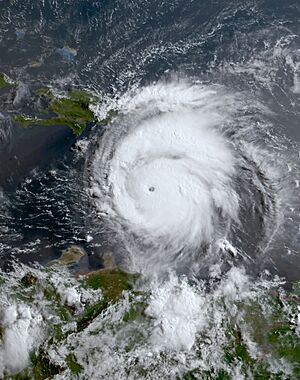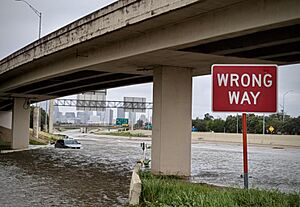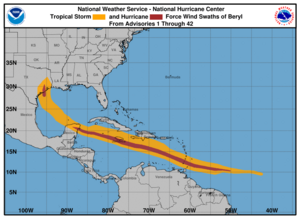Hurricane Beryl facts for kids

Beryl shortly after peak intensity over the eastern Caribbean Sea on July 2
|
|
| Meteorological history | |
|---|---|
| Formed | June 28, 2024 |
| Post-tropical | July 9, 2024 |
| Dissipated | July 11, 2024 |
| Category 5 tropical cyclone | |
| 1-minute sustained (SSHWS/NWS) | |
| Highest winds | 165 mph (270 km/h) |
| Lowest pressure | 934 mbar (hPa); 27.58 inHg |
| Overall effects | |
| Fatalities | 64 total |
| Damage | >$6.86 billion (2024 USD) |
| Areas affected |
|
|
Part of the 2024 Atlantic hurricane season |
|
| Effects • Texas • Tornado outbreak |
|
Hurricane Beryl was a very strong and dangerous storm that hit parts of the Caribbean, Mexico's Yucatán Peninsula, and the United States in June and July 2024. It was a Category 5 Atlantic hurricane, which is the strongest type of hurricane.
Beryl was special because it formed earlier than any other Category 5 hurricane on record. It was also the second Category 5 storm ever to happen in July. The storm caused a lot of damage and sadly, many people lost their lives.
Beryl started as a tropical wave off the coast of Africa on June 25. It quickly grew stronger as it moved west. On July 1, Beryl hit the island of Carriacou in Grenada as a powerful Category 4 hurricane, causing huge destruction.
The hurricane got even stronger over the Caribbean Sea, becoming a Category 5 storm on July 2. It had winds of about 165 miles per hour (265 km/h). Beryl then slowly weakened as it moved past Jamaica and the Cayman Islands.
It briefly became a strong Category 3 hurricane again before hitting Tulum, Quintana Roo, Mexico, as a Category 2 storm on July 5. After weakening over Mexico, it moved into the Gulf of Mexico. Beryl then became a Category 1 hurricane again before making its last landfall near Matagorda, Texas, on July 8. The storm then weakened over land and finally disappeared over Ontario, Canada, on July 11.
Hurricane Beryl caused widespread damage and many deaths. The northern islands of Grenada, like Carriacou, and some southern islands of Saint Vincent and the Grenadines were hit very hard. In Venezuela, six people died. Mexico also saw damage, mostly to trees, power poles, and roofs, along with some flooding.
In the United States, Texas had severe flooding and wind damage, with at least 36 deaths reported in the Houston area. Beryl also caused many tornadoes in Texas, Louisiana, Arkansas, and other states. As of July 25, a total of 64 deaths were confirmed, and the damage cost was estimated to be over $6.86 billion.
Contents
How Hurricane Beryl Formed and Traveled
The National Hurricane Center (NHC) started watching a weather system near West Africa on June 25. This system had some rain but was not yet organized. The ocean water was very warm, and the air conditions were perfect for a storm to grow.
On June 28, the system became strong enough to be called Tropical Depression Two. It was about 1,225 miles (1,970 km) east-southeast of Barbados.
Growing into a Powerful Hurricane
The depression moved west into an area with warm water and light winds. This allowed it to grow very quickly. Just six hours after forming, it became Tropical Storm Beryl. The storm's thunderstorms organized into a clear pattern, and soon, an eye formed in the center.
On June 29, Beryl became a hurricane. By June 30, it was a major hurricane, reaching Category 4 strength with winds of 130 mph (215 km/h). The storm then went through a change in its eye, weakening slightly on July 1.
But Beryl quickly got stronger again. On July 1, it hit Carriacou, Grenada, as a very strong Category 4 hurricane. After that, it moved into the Caribbean Sea and became a Category 5 hurricane on July 2. At its strongest, Beryl had winds of 165 mph (265 km/h).
Weakening and Landfalls
Strong winds higher up in the atmosphere caused Beryl to slowly weaken to a Category 4 storm. It passed south of the Dominican Republic and then very close to the southern coast of Jamaica on July 3.
Beryl continued to weaken, falling below major hurricane strength on July 4. It briefly became a Category 3 hurricane again that evening. On July 5, Beryl made landfall near Tulum, Quintana Roo, Mexico, as a Category 2 hurricane.
Over land in Mexico, Beryl quickly weakened to a tropical storm. It then moved into the Gulf of Mexico. On July 8, Beryl strengthened back into a Category 1 hurricane before making its final landfall near Matagorda, Texas.
After hitting Texas, Beryl weakened over land. It became a tropical storm and then a tropical depression. On July 9, it changed into a post-tropical cyclone over Arkansas. The storm's leftover moisture moved into Ontario, Canada, before finally disappearing on July 11.
Getting Ready for the Storm
People in many countries prepared for Hurricane Beryl as it moved across the Atlantic.
Caribbean Islands Get Ready
Barbados, Grenada, Saint Vincent and the Grenadines, and Saint Lucia were all put under hurricane warnings on June 29. Tobago and Martinique also received hurricane warnings.
- Tobago: A state of emergency was declared. Schools were closed, and ferries were cancelled. Over 140 people went to shelters.
- Barbados: Businesses were ordered to close, and water lines were shut down. More than 400 people stayed in hurricane shelters.
- Grenada: A curfew was put in place, and a week-long state of emergency was declared. A big meeting was cancelled. Over 1,600 people went to shelters.
- Saint Vincent and the Grenadines: A curfew was imposed, and the government shut down. Over 1,750 people went to shelters.
- Jamaica: The island was put under a hurricane warning on July 2. A state of emergency was declared, and people in flood-prone areas were told to evacuate. Airports were closed, and a nationwide curfew was implemented. Over 1,000 people went to shelters.
- Cayman Islands: A hurricane warning was issued on July 2. Airports were closed, and nearly 4,000 people were evacuated from the islands. Several hundred people went to government shelters.
Cruise lines like Norwegian, Carnival, and Disney changed their routes to avoid the hurricane. Many airlines also changed their flight schedules in the region.
Mexico and Belize Prepare
- Quintana Roo, Mexico: This state, which includes popular tourist areas like Cancún, was put on a red warning. Over 2,000 shelters were opened, and schools and public beaches were closed. Officials prepared large amounts of drinking water. They even moved sea turtle eggs from beaches to protect them from storm surge. About 2,200 people stayed in shelters.
- Belize: A Tropical Storm Watch was issued for the Caribbean coast, later upgraded to a warning. Residents in northern Belize were told to prepare for flooding.
United States Gulf Coast Gets Ready

In Texas, 121 counties were declared disaster areas. Hurricane and storm surge watches were put in place for the coast. Some coastal areas had mandatory evacuation orders. Oil companies moved employees from offshore platforms. FEMA sent supplies and people to Texas to help.
All flights in and out of Houston's airports were delayed or cancelled on July 6. Train services were also suspended in the Houston area.
Hurricane Beryl's Impact
| Country/Territory | Deaths | Damage (USD) | Ref |
|---|---|---|---|
| Barbados | 0 | Unknown | |
| Cayman Islands | 0 | Unknown | |
| Canada | 1 | Unknown | |
| Dominican Republic | 0 | Unknown | |
| Grenada | 6 | $430 million | |
| Haiti | 0 | Unknown | |
| Jamaica | 4 | $41.6 million | |
| Martinique | 0 | Unknown | |
| Mexico | 0 | $90 million | |
| Saint Lucia | 0 | $2 million | |
| Saint Vincent and the Grenadines | 8 | $300 million | |
| Trinidad and Tobago | 0 | Unknown | |
| United States | 39 | >$6 billion | |
| Venezuela | 6 | Unknown | |
| Total | 64 | >$6.86 billion | |
Hurricane Beryl caused a lot of damage and disruption across many countries.
Damage in the Caribbean
Beryl hit the Lesser Antilles as a very strong Category 4 hurricane. It damaged buildings, knocked down trees, and caused widespread power and communication outages.
- Saint Vincent and the Grenadines: Eight people died. Over 90% of homes on islands like Canouan, Mayreau, and Union were damaged or destroyed.
- Grenada: The island of Carriacou lost almost all its plants and trees. Houses and buildings were badly damaged, and the power grid was severely affected. Six people died in Grenada. The estimated damage was $430 million.
- Barbados: Homes and roads were flooded. Roofs, trees, and power poles were damaged. About 90% of the country's fishing boats were damaged or destroyed.
- Trinidad and Tobago: Power outages and water service disruptions happened in Tobago. Flooding occurred in northern Trinidad.
- Martinique: 10,000 customers lost power, and downtown Fort-de-France experienced knee-deep flooding.
- Saint Lucia: Trees and power lines were downed. Many weaker homes were damaged. Initial damage estimates were $2 million.
- Venezuela: Strong winds and heavy rains affected northeastern Venezuela. Six people died, and over 6,000 houses were damaged in the state of Sucre. The city of Cumanacoa was flooded.
Impact in the Greater Antilles
- Dominican Republic: Beryl brought strong winds and rough waves. It displaced 89 people and affected water services. Some roads were covered with debris, and coastal areas experienced flooding.
- Jamaica: Beryl caused significant damage to homes, crops, and infrastructure. Four people died. Over 400,000 people lost power. The storm passed close to Kingston, bringing strong winds and heavy rain.
- Cayman Islands: Flash floods and mudslides were reported. Nearly 6,000 people on Grand Cayman Island lost power.
Mexico's Experience
Beryl brought heavy rains and strong winds to Cancún and the Riviera Maya in Quintana Roo. This caused downed trees, power lines, and widespread flooding. Many areas lost electricity. Tourist areas did not suffer major damage. Damage in Mexico was estimated at $90 million.
United States Impact

The cost of wind damage in the United States was estimated to be between $2.5 billion and $3.5 billion. Hurricane Beryl also caused a large number of tornadoes. On July 8, 113 tornado warnings were issued, which was a record for a single day in July.
- Texas: Beryl made landfall near Matagorda. Winds of over 60-70 mph (97-113 km/h) were recorded, with a peak gust of 97 mph (156 km/h) in Brazoria. Homes were damaged or destroyed in coastal towns like Surfside Beach. In Houston, over 2.7 million people lost power, and more than 8 inches (200 mm) of rain fell. There were 16 confirmed tornadoes in Texas.
- Louisiana: The storm brought severe weather to northwestern Louisiana, with many tornado warnings and power outages. There were 25 confirmed tornadoes in the state, including some large and long-tracked ones. One tornado killed a woman and injured her two children near Benton. Over 20,000 customers lost power.
- Arkansas: Arkansas was hit by rain as Beryl moved through as a tropical depression. The highest rainfall was 8 inches (200 mm). Six tornadoes were confirmed. Almost 14,000 people lost power.
- Ohio Valley (Kentucky, Indiana, Illinois): Beryl's remnants caused heavy rain and tornadoes. In Indiana, a strong EF3 tornado heavily damaged an industrial area and derailed a train near Mount Vernon. Several other tornadoes were confirmed. Many fields in Illinois were flooded.
- Great Lakes (Michigan, New York): Heavy rainfall in Michigan caused flash flooding and power outages. In New York, 25,000 customers lost power. Seven tornadoes were confirmed, including an EF2 tornado that destroyed farm buildings near Eden.
- New England (New Hampshire, Vermont): Towns in northern New Hampshire were severely damaged by flooding. In Vermont, severe flooding washed away bridges and damaged homes. Over 100 people needed rescuing. Montpelier was hit hard with over 6 inches (150 mm) of rain.
Canada's Experience
The remnants of Beryl brought heavy rain to southern Ontario and southwest Quebec, causing localized flooding. Two weak tornadoes occurred in the London, Ontario, area, damaging crops and trees. In Quebec, parts of Montreal received up to 4 inches (100 mm) of rain, flooding highways and basements. Over 9,000 customers lost power. Beryl's moisture also caused flash flooding and washed out roads in Nova Scotia.
After the Storm
After Hurricane Beryl passed, many organizations and governments offered help.
- The United Nations provided $4 million in aid.
- The Government of Canada announced $1.2 million in humanitarian assistance.
- The United States Agency for International Aid (USAID) gave $4.5 million in aid, including $2.5 million for Jamaica.
- The European Union authorized $450,000 in humanitarian aid for countries in the Lesser Antilles.
- The World Food Programme sent 5,000 food kits to affected Caribbean countries.
The Royal Navy sent a warship with supplies to the Cayman Islands. Leaders from Antigua and Barbuda, Saint Vincent and the Grenadines, and Grenada asked for their debts to be cancelled and for more funding to help after natural disasters.
In Barbados, local businesses and Rotary Clubs donated $40,000 to help repair the fishing fleet, as most boats were not insured.
Hurricane Beryl's Records
Hurricane Beryl broke several records:
- It was the easternmost hurricane to form in the tropical Atlantic in June.
- It became the earliest Category 4 hurricane on record in the Atlantic, beating a record set in 2005 by Hurricane Dennis.
- It was the strongest June hurricane ever recorded by wind speed, surpassing Hurricane Audrey from 1957.
- It became the earliest Category 5 hurricane on record, beating Hurricane Emily from 2005.
- It was the strongest July hurricane ever recorded by wind speed.
- It was the first tropical system to grow very quickly in the Main Development Region of the Atlantic during June.
- Beryl went from a tropical storm to a Category 5 hurricane in only 42 hours. Only six other Atlantic storms have done this so quickly, and Beryl was the only one to do it before September.
Scientists believe that climate change likely made Beryl's extreme winds and heavy rain even stronger. Natural changes in the climate also played a part.
See also
 In Spanish: Huracán Beryl para niños
In Spanish: Huracán Beryl para niños
- Other storms of the same name
- List of Category 5 Atlantic hurricanes
- Timeline of the 2024 Atlantic hurricane season



